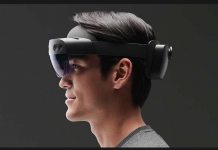Essentially, the Moving Platform tackles an issue HoloLens has had for some time… how can the headset work in a moving environment without the sensors becoming confused. Microsoft and VW say they have overcome this issue. By the way, it is easy to instantly assume wearing a headset when driving is not a great idea. However, it is worth remembering the HoloLens 2 is an augmented reality device. That means it shows the wearer the real world around them and places virtual elements in or on to the environment. As we already know, HoloLens can track movement via its camera sensors and the inertial measurement unit (sensors like gyroscopes and accelerometers). When moving in a car, these readings can conflict with each other. This is because while the car is moving, the HoloLens is not and believes it is in a static environment. VW was initially testing using the standard HoloLens 2 to teach drivers the best way to lap a racetrack. However, the sensor confusion meant the device was not working as expected. VW began working with Microsoft in 2018 to find a solution. That solution has evolved into the Moving Platform feature.
Moving Platform
The feature basically places virtual objects in the real world both inside and outside the car: “We connected a positioning system that tracks the location of the vehicle. This way we were able to also place 3D elements such as information on point of interests outside of the car. This opens up completely new possibilities to not only display holograms within the driver’s forward-facing field of view, but also wherever the user wearing the glasses is looking,” says Michael Wittkämper, augmented reality expert at Volkswagen. Microsoft debuted the Moving Platform earlier this year. The company says the tool is attracting the attention of maritime companies and other organizations. Tip of the day: With a single registry tweak, it’s possible to add a ‘Take Ownership’ button to the right-click context menu that performs all of the necessary actions for you. You’ll gain full access to all possible actions, including deletion, renaming, and more. All files and subfolders will also be under your name. The Take Ownership context menu will set the currently active user as the owner of the files, though they must also be an administrator. They can then enter the folder or modify the file as they usually would.




